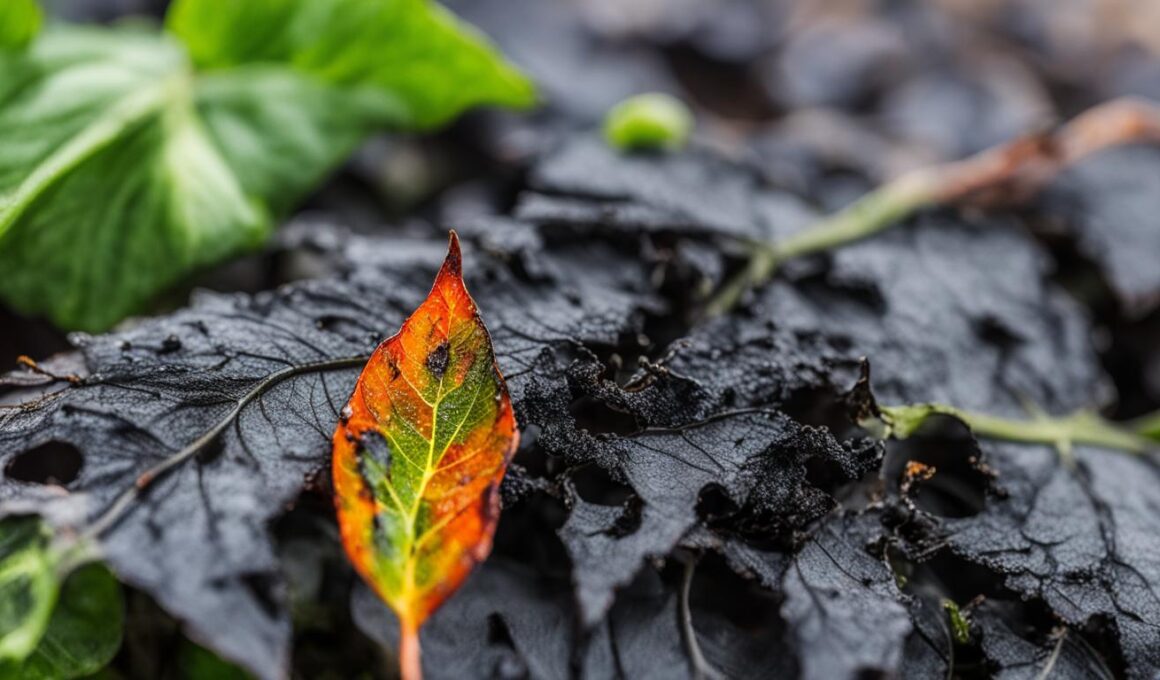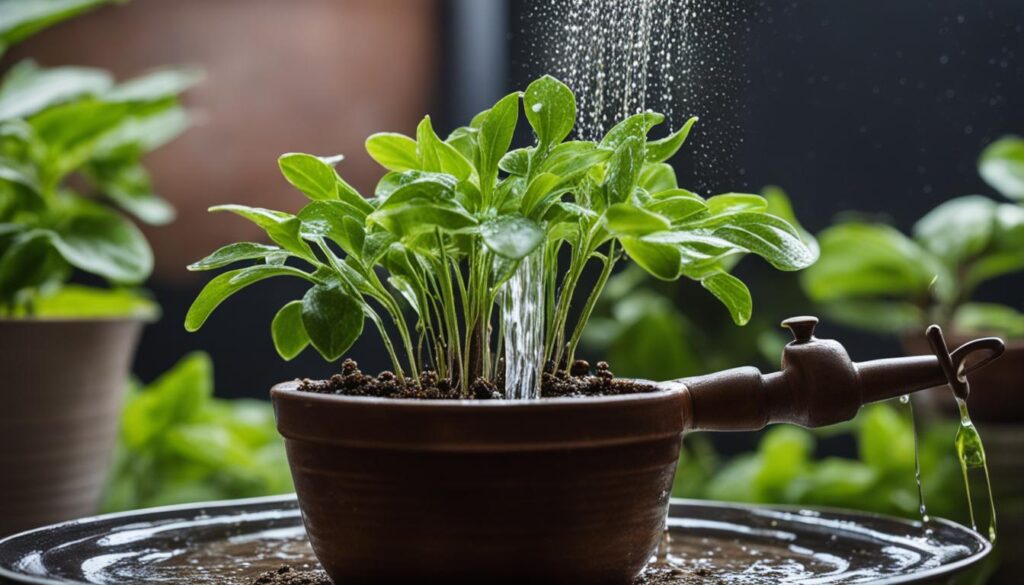If you’re facing the problem of burnt tomato leaves, don’t worry! We have the solutions for you. When you notice weak, stunted, or dying plants with limp, wilted, or crinkled leaves, it’s likely that your tomato plants are suffering from overabundance of nutrients. This can lead to discoloration, spots, and misshapen leaves, as well as excessive foliage with few flowers and fertilization buildup in the soil. But fret not, with a few simple steps, you can revive your tomato plants and get your green thumb back on track.
Now let’s dive into the solutions to revive your burnt tomato leaves and restore the health of your plants.
How to Remove Excess Fertilizer and Leach the Soil
If you notice visible signs of overfertilization in your tomato plants, such as burnt or wilted leaves, it’s important to take immediate action to prevent further damage. One effective solution is to remove the excess fertilizer and leach the soil. This process helps to flush out the excessive nutrients and restore a healthy balance to the plant’s environment.
To remove excess fertilizer, start by gently brushing off any visible fertilizer on the plant leaves with a soft brush or cloth. Be careful not to rub or scrub the leaves harshly, as this could cause further damage. Next, focus on the topsoil surrounding the plant. Use a small garden trowel to carefully scoop out any concentrated areas of fertilizer. Dispose of the removed fertilizer properly, away from your tomato plants.
Once excess fertilizer has been removed, it’s time to leach the soil. Leaching involves using distilled, room-temperature water to flush out the excessive nutrients. Place a saucer or tray under the tomato plant to collect the water runoff. Slowly pour the water over the soil, allowing it to soak in and move through the root system. Continue this process until you observe water draining into the saucer or tray below.
“Removing excess fertilizer and leaching the soil are crucial steps in rectifying overfertilization. By removing the visible fertilizer and flushing out the excessive nutrients, you can help your tomato plants recover and regain their vitality.” – Gardening Expert
Remember to use distilled water for leaching, as tap water may contain additional chemicals that could harm your plants. It’s also important to use room-temperature water to prevent shocking the plant’s roots. After leaching, allow the soil to dry slightly before watering again. This will help prevent the buildup of fertilizer in the future and promote healthier growth.
| Steps to Remove Excess Fertilizer and Leach the Soil |
|---|
| 1. Gently brush off visible fertilizer from plant leaves |
| 2. Scoop out concentrated areas of fertilizer from the topsoil |
| 3. Dispose of removed fertilizer properly |
| 4. Place a saucer or tray under the plant |
| 5. Slowly pour distilled, room-temperature water over the soil |
| 6. Allow water to drain into the saucer or tray |
| 7. Wait for the soil to dry slightly before watering |
By following these steps, you can effectively remove excess fertilizer and leach the soil, providing your tomato plants with the best chance for recovery. Be sure to monitor your plants closely for any signs of improvement and adjust your fertilization practices accordingly to prevent overfertilization in the future.
Trimming and Replanting Overfertilized Plants
If your tomato plant has been severely overfed, it may require some extra care to restore its health. Trimming the damaged foliage and giving the plant a fresh start can help promote recovery. Additionally, repotting the overfertilized plant in new soil can provide a nutrient-rich environment for growth.
When trimming the plant, focus on removing any leaves or branches that show signs of damage. This helps redirect the plant’s energy towards new growth and prevents further stress on the plant. Use clean and sharp pruning shears to make clean cuts, ensuring minimal damage to the plant.
After trimming, it’s crucial to repot the overfertilized plant in fresh soil. Choose a pot that provides adequate drainage, as excess water can worsen the situation. Gently remove the plant from its current pot, loosening the root ball if necessary, and place it in the new pot filled with well-draining soil. This allows the plant to establish new roots and regain its strength.
It’s important to note that after repotting an overfertilized plant, it’s best to avoid fertilizing for several weeks. This gives the plant time to recover and adjust to its new environment. Monitor the plant closely during this period, ensuring it receives proper sunlight, water, and care to facilitate its healing process.
Common Symptoms of Overfertilization
Overfertilization can have detrimental effects on tomato plants, and it’s important to recognize the signs to take appropriate action. Here are some common symptoms of overfertilization:
- Drooping leaves: Excess fertilizer can cause the leaves to become wilted and limp, giving the plant a droopy appearance.
- Yellowing leaves: If the leaves start turning yellow, especially from the bottom up, it may indicate overfertilization.
- Misshapen leaves: Overfertilization can lead to misshapen leaves with irregular growth patterns or abnormal leaf structures.
- Excessive foliage with few flowers: An overabundance of nutrients can result in excessive leaf growth at the expense of flower production.
- Fertilization buildup in the soil: A visible presence of fertilizer on the soil surface or a gradual buildup of fertilizer over time can indicate overfertilization.
Proper diagnosis of overfertilization symptoms is crucial in addressing the issue effectively and preventing further damage to the plants.
To confirm if your tomato plants are indeed suffering from overfertilization, it’s recommended to consult with a garden center professional or a horticulturist for a more accurate assessment. Removing damaged leaves and monitoring the plant closely for any changes can help in the recovery process. Remember, prevention is key, so always follow proper fertilization techniques and avoid overfertilization to keep your tomato plants healthy and thriving.
| Symptom | Description |
|---|---|
| Drooping leaves | Leaves appear wilted and limp, giving the plant a droopy appearance. |
| Yellowing leaves | Leaves turn yellow, especially from the bottom up. |
| Misshapen leaves | Leaves grow in irregular shapes or have abnormal growth patterns. |
| Excessive foliage with few flowers | Plant produces excessive foliage but lacks flower production. |
| Fertilization buildup in the soil | Visible presence or gradual buildup of fertilizer on the soil surface. |
Preventing Overfertilization in the Future
Proper fertilization techniques are vital for maintaining the health and vitality of your tomato plants. By following a few simple guidelines, you can prevent overfertilization and ensure optimal growth.
1. Choose the Right Fertilizer
When selecting a fertilizer for your tomato plants, opt for one that is low in nitrogen. Nitrogen is the nutrient most commonly associated with overfertilization. By choosing a fertilizer with a lower nitrogen content, you can reduce the risk of applying too much nitrogen to your plants.
2. Follow the Recommended Application Rates
Always follow the instructions on the fertilizer package regarding the recommended application rates. Applying more fertilizer than is necessary can lead to overfertilization. Start with one quarter or one half of the recommended amount, and monitor your plants closely for any signs of nutrient stress.
3. Consult with Garden Center Professionals
If you are unsure about the proper fertilization techniques for your tomato plants, don’t hesitate to seek advice from professionals at your local garden center. They can provide guidance on the best fertilizer choices and application methods for your specific growing conditions.
4. Regularly Monitor Your Plants
Closely monitoring your plants is essential for preventing overfertilization. Keep an eye out for any signs of nutrient stress, such as yellowing leaves, misshapen leaves, or excessive foliage with few flowers. If you notice any of these symptoms, take immediate action to address the issue.
By following these proper fertilization techniques and closely monitoring your plants, you can ensure the healthy growth of your tomato plants and prevent the negative effects of overfertilization.
Can the Same Techniques for Fixing Overwatered Plants be Applied to Revive Burnt Tomato Leaves?
When dealing with burnt tomato leaves, using the same techniques for how to fix overwatered plants can help revive them. Adjusting the watering schedule, checking the soil’s drainage, and providing proper sunlight can aid in the recovery process. Pruning damaged leaves and ensuring proper nutrition are also essential for revival.
Conclusion
Congratulations on taking the necessary steps to revive your burnt tomato leaves! By following the solutions we’ve discussed, you can bring new life to your tomato plants and ensure their future health and vibrancy.
In this article, we’ve covered various ways to address overfertilization and revive your plants. Firstly, removing excess fertilizer and leaching the soil can help move the excess nutrients away from the plant’s roots. Flooding the root system with distilled water and allowing it to drain away effectively washes away the fertilizer.
If your plants have been severely overfed, trimming damaged foliage and replanting them in fresh soil can promote their healing process. It’s crucial to refrain from fertilizing them for several weeks to give them time to recover from the excess nutrients.
Preventing overfertilization in the future is equally important. By using a fertilizer without nitrogen and following the recommended amount, you can avoid overfeeding your plants. Proper nutrient management, regular monitoring, and seeking advice from garden center professionals will help you maintain healthy and thriving tomato plants.
FAQ
How do I know if my tomato plants are suffering from overabundance of nutrients?
Some signs of overfertilization in tomato plants include weak, stunted, or dying plants with limp, wilted, or crinkled leaves. Discoloration, spots, and misshapen leaves are also indicators, along with excessive foliage with few flowers and fertilization buildup in the soil.
What should I do if I notice excess fertilizer on my tomato plants or in the soil?
To prevent further overfertilization, remove any visible fertilizer from the plant or topsoil. Leach the soil with distilled, room-temperature water to move the excess fertilizer away from the plant’s roots. Flooding the root system and allowing the water to drain away can help wash away the fertilizer.
How should I address severe overfertilization in my tomato plant?
If your plant has been severely overfed, it may be necessary to remove damaged foliage and trim the plant to ensure its future health. If possible, replant the overfertilized plant in new, fresh soil to give it an opportunity to heal. Avoid fertilizing the plant for several weeks to allow it to recover from the overabundance of nutrients.
What are the symptoms of overfertilization in tomato plants?
Symptoms of overfertilization in tomato plants include drooping leaves, yellowing leaves, misshapen leaves, excessive foliage with few flowers, and fertilization buildup in the soil. It’s important to remove damaged leaves and closely monitor the plant for any changes.
How can I prevent overfertilization in my tomato plants?
To avoid overfertilization, it is recommended to use a fertilizer without nitrogen and only use one quarter or one half of the recommended amount. Following the instructions on the fertilizer package and consulting with a garden center professional can help prevent future overfertilization. Proper nutrient management and regular plant monitoring are essential for maintaining healthy plants.
Can burnt tomato leaves be revived?
Yes, with the right techniques, burnt tomato leaves can be revived. Removing excess fertilizer, leaching the soil, trimming and replanting, and preventing overfertilization in the future are key steps in the process. By closely monitoring your plants and taking appropriate action, you can restore vibrancy to your tomato garden.












